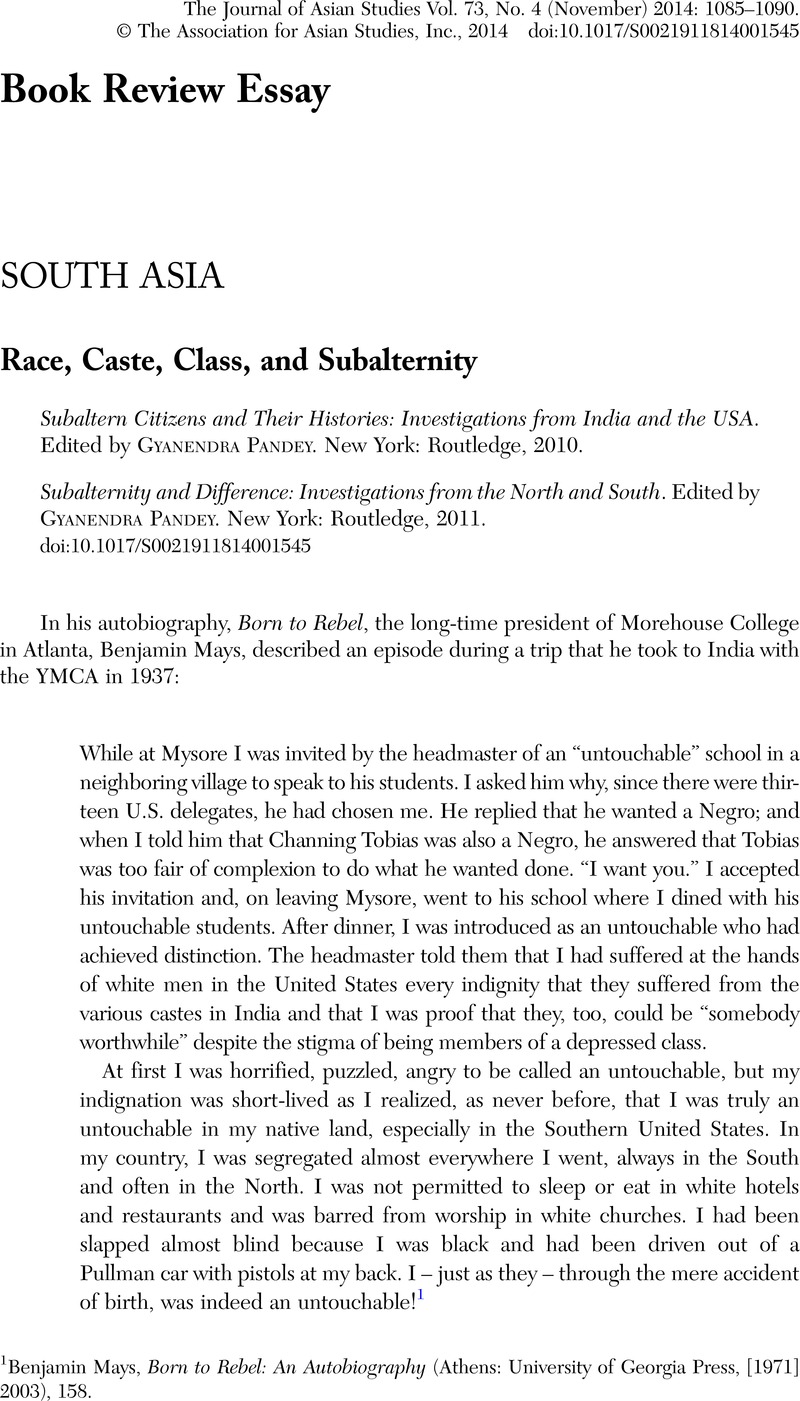Article contents
Race, Caste, Class, and Subalternity
Published online by Cambridge University Press: 20 November 2014
Abstract

- Type
- Book Review Essays: South Asia
- Information
- Copyright
- Copyright © The Association for Asian Studies, Inc. 2014
References
1 Mays, Benjamin, Born to Rebel: An Autobiography (Athens: University of Georgia Press, [1971] 2003), 158Google Scholar.
2 Nico Slate, “Do Revolutions Need Passports? From Gandhi to King to the Arab Spring,” Berfrois, January 19, 2012, http://www.berfrois.com/2012/01/nico-slate-satyagraha-on-the-spot/ (accessed July 31, 2014).
3 Immerwahr, Daniel, “Caste or Colony? Indianizing Race in the United States,” Modern Intellectual History 4, no. 2 (2007): 275–301CrossRefGoogle Scholar; Daniel Immerwahr, “An Informal Memo on B. R. Ambedkar and U.S. Blacks” (unpublished manuscript, May 2008), http://www.columbia.edu/itc/mealac/pritchett/00ambedkar/timeline/txt_immerwahr_2008.pdf (accessed July 31, 2014).
4 For a pointed critical discussion of the latter perspective, see Prashad, Vijay, “Afro-Dalits of the Earth, Unite,” African Studies Review 43, no. 1 (2000): 189–201CrossRefGoogle Scholar.
5 Pratham Banerjee's essay in Subaltern Citizens and Their Histories examines the representation of the tribals or Adivasis as the purveyors of the primitive and original in Indian culture like the black American peasantry were seen as the source of “authentic” black culture during the Harlem Renaissance.
6 Coleman, Major G., Darity, William Jr., and Sharpe, Rhonda V., “Are Reports of Discrimination Valid? Considering the Moral Hazard Effect,” American Journal of Economics and Sociology 67, no. 2 (2008): 149–75CrossRefGoogle Scholar.
7 Heretofore, I was completely unaware of the meaning of the folk song “Big Rock Candy Mountain.”
8 Pearson, Jay, “Can't Buy Me Whiteness: New Lessons from the Titanic on Race, Ethnicity, and Health,” Du Bois Review 5, no. 1 (2008): 27–48CrossRefGoogle Scholar; Geronimus, Arline T., “Jedi Public Health: Leveraging Contingencies of Social Identity to Grasp and Eliminate Racial Health Inequality,” in Mapping “Race”: Critical Approaches to Health Disparities Research, eds. Gómez, Laura and López, Nancy (New Brunswick, N.J.: Rutgers University Press, 2013), 163–78Google Scholar.
9 Gokhale-Turner, Jayahsree, “The Dalit Panthers and the Radicalisation of the Untouchables,” Journal of Commonwealth and Comparative Politics 17, no. 1 (1979): 77–93CrossRefGoogle Scholar; Sutton, Paul, “Black Power in Trinidad and Tobago: the ‘Crisis’ of 1970,” Journal of Commonwealth and Comparative Politics 24, no. 2 (1983): 115–32CrossRefGoogle Scholar.
10 Pandey, Gyanendra, “Can There Be a Subaltern Middle Class? Notes on African American and Dalit History,” Public Culture 21, no. 2 (2009): 321–42CrossRefGoogle Scholar.
11 Bass, Jack and Thompson, Marilyn W., Strom: The Complicated Personal and Political Life of Strom Thurmond (New York: Public Affairs, 2005)Google Scholar.
12 Ibid., 118.
13 Amilcar Cabral, “The Weapon of Theory,” address delivered to the first Tricontinental Congress Conference of the Peoples of Asia, Africa, and Latin America, Havana, Cuba, January 1966, http://www.marxists.org/subject/africa/cabral/1966/weapon-theory.htm (accessed July 31, 2014).
- 1
- Cited by


